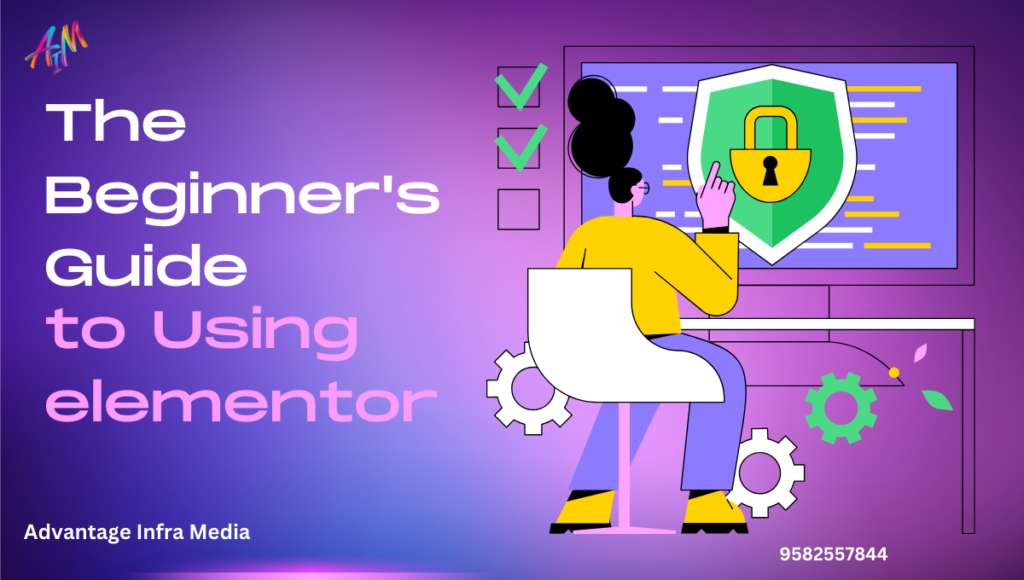12. Mastering Elementor’s Advanced Features
Global Widgets
Global widgets in Pro allow you to save and reuse a widget across different pages of your website. This feature is particularly useful for elements like call-to-action buttons, forms, or any recurring design elements. (The Beginner’s Guide to Using elementor)
How to Use Global Widgets:
- Create a Widget: Design a widget as you normally would.
- Save as Global: Right-click on the widget and select “Save as Global.”
- Reuse the Global Widget: Drag the global widget from the “Global” section of the widget panel to any page.
When you update a global widget, changes are applied universally, ensuring consistency across your site.
Theme Builder
The Theme Builder is a powerful feature in Elementor Pro that allows you to design custom headers, footers, archive pages, single posts, and more.
Using the Theme Builder:
- Access Theme Builder: Go to Templates > Theme Builder in the WordPress dashboard.
- Create a Template: Choose the type of template you want to create (e.g., header, footer, single post).
- Design Your Template: Use design your template. You can add dynamic content from your site, like post titles, featured images, and custom fields.
- Assign the Template: Set conditions to determine where the template should be applied (e.g., entire site, specific pages, or categories).
WooCommerce Builder
For e-commerce sites, Elementor Pro offers WooCommerce Builder, enabling you to design custom product pages, shop pages, and other WooCommerce-related templates.
Creating Custom Product Pages:
- Go to Templates > Theme Builder > Single Product.
- Design the Product Page: Use WooCommerce widgets to add elements like product title, price, description, and add-to-cart button.
- Set Conditions: Specify where the template should be applied, such as all products or specific categories.
Popup Builder
The Popup Builder in Elementor Pro lets you create custom popups for various purposes, such as promotions, email signups, or announcements. (The Beginner’s Guide to Using elementor)
Designing a Popup:
- Go to Templates > Popups.
- Create a New Popup: Design your popup using the editor.
- Set Display Conditions: Define when and where the popup should appear (e.g., on page load, after scrolling, on exit intent).
- Publish the Popup: Ensure it integrates seamlessly with your site’s design and functionality.
13. Elementor Integrations
Elementor integrates with numerous third-party tools and plugins, enhancing its functionality and making it a versatile tool for any website.
SEO Plugins
Elementor works well with popular SEO plugins like Yoast SEO and Rank Math. You can optimize your content directly within the interface, ensuring your pages are SEO-friendly. (The Beginner’s Guide to Using elementor)
Tips for SEO Integration:
- Use SEO Widgets: Utilize widgets like Table of Contents and Breadcrumbs to improve your site’s SEO.
- Optimize Images: Ensure all images have proper alt text and are compressed for faster loading times.
Marketing Tools
Elementor integrates with email marketing services like Mailchimp, ActiveCampaign, and ConvertKit, allowing you to create and embed sign-up forms directly on your pages.
Setting Up Email Integrations:
- Add a Form Widget: Drag the form widget to your page.
- Configure Form Fields: Customize the form fields to collect the necessary information.
- Integrate with Email Service: Under the “Actions After Submit” section, choose your email service and configure the integration.
Social Media
Integrate your social media profiles and feeds using social media widgets. This can enhance your site’s engagement and increase your social media following. (The Beginner’s Guide to Using elementor)
Adding Social Media Widgets:
- Drag a Social Icons Widget: Place the widget where you want your social media icons to appear.
- Customize Icons: Choose the icons and links for your social media profiles.
- Style the Widget: Customize the look of your social icons to match your site’s design.
14. Troubleshooting and Support
Even with its user-friendly interface, you might encounter some issues while using Elementor. Here are some common problems and their solutions: (The Beginner’s Guide to Using elementor)
Common Issues
- Elementor Not Loading:
- Solution: Check for plugin conflicts by deactivating all other plugins and reactivating them one by one.
- Responsive Issues:
- Solution: Use responsive mode to adjust your design for different devices.
- Slow Performance:
- Solution: Optimize your site by using a caching plugin, optimizing images, and minimizing the use of heavy elements.
Getting Support
Offers extensive support resources, including documentation, forums, and customer support for Pro users.
Support Resources:
- Elementor Documentation: Detailed guides and tutorials.
- Elementor Community: Join the Elementor Facebook group or community forums for help from other users.
- Customer Support: Pro users can access dedicated customer support through the website.
15. Elementor vs. Other Page Builders
Elementor is one of several page builders available for WordPress. Here’s a comparison with other popular page builders: (The Beginner’s Guide to Using elementor)
Elementor vs. WPBakery
- Ease of Use: Elementor’s interface is generally considered more intuitive.
- Features: Both offer a range of features, but Elementor Pro provides more advanced design capabilities.
- Performance: Tends to perform better with faster loading times.
Elementor vs. Divi
- Design Flexibility: Divi offers extensive customization but can be overwhelming for beginners.
- Speed: Elementor’s inline editing is faster and more responsive.
- Templates: Both offer a large number of pre-designed templates, but Elementor’s library is continually expanding.
Elementor vs. Beaver Builder
- User Interface: Elementor’s UI is more modern and user-friendly.
- Customization: Elementor offers more design and customization options.
- Pricing: Beaver Builder’s pricing can be higher, especially for advanced features.
16. Custom CSS and Code Integration
For those with coding knowledge, Elementor offers the flexibility to integrate custom CSS and other codes, allowing for even more customization and control over your site’s appearance and functionality.
Adding Custom CSS
With Elementor Pro, you can add custom CSS directly within the editor, applying styles globally or to specific elements.
Steps to Add Custom CSS:
- Select an Element: Click on the element you want to style.
- Open Advanced Tab: Navigate to the “Advanced” tab in the Elementor panel.
- Custom CSS Section: Scroll down to the “Custom CSS” section and enter your CSS code.
Custom CSS enables you to implement precise design adjustments, ensuring your site adheres to your specific aesthetic and functional requirements. (The Beginner’s Guide to Using elementor)
Embedding Custom Code
Elementor allows you to embed custom HTML, JavaScript, and shortcodes, making it possible to integrate third-party tools, custom functionality, and advanced design elements. (The Beginner’s Guide to Using elementor)
Embedding Code:
- HTML Widget: Drag the HTML widget to your page.
- Enter Code: Add your custom HTML, JavaScript, or shortcodes in the HTML widget’s content area.
This feature is particularly useful for adding scripts, embedding forms, or incorporating custom functionalities that aren’t available through standard widgets. (The Beginner’s Guide to Using elementor)
17. Performance Optimization
Ensuring your Elementor-powered website performs well is crucial for user experience and SEO. Here are some tips to optimize performance: (The Beginner’s Guide to Using elementor)
Image Optimization
Large images can slow down your website significantly. Use optimized images to ensure faster loading times.
Tips for Image Optimization:
- Use Compressed Images: Tools like TinyPNG and ImageOptim can compress images without losing quality.
- Lazy Loading: Enable lazy loading to defer offscreen images from loading until the user scrolls to them.
Minimize HTTP Requests
Reduce the number of HTTP requests by minimizing the use of plugins and combining CSS and JavaScript files.
Combine CSS and JS Files:
- Caching Plugins: Use caching plugins like WP Rocket or W3 Total Cache to combine and minify CSS and JS files.
Use a Content Delivery Network (CDN)
A CDN can significantly improve your site’s loading times by serving your content from servers closer to your visitors. (The Beginner’s Guide to Using elementor)
Popular CDN Services:
- Cloudflare: Offers free and premium plans with a range of features.
- KeyCDN: Provides robust performance and easy integration with WordPress.
18. Elementor Add-ons and Extensions
Enhance Elementor’s functionality with third-party add-ons and extensions. These tools provide additional widgets, templates, and features that can further customize your site. (The Beginner’s Guide to Using elementor)
Popular Elementor Add-ons
Elementor Extras:
- Features: Adds unique widgets and extensions.
- Best For: Enhancing design flexibility with additional elements like carousels, galleries, and more.
Essential Addons for Elementor:
- Features: Offers over 70 additional elements and extensions.
- Best For: Extending core Elementor functionality with elements like post grids, interactive promos, and content toggles.
PowerPack for Elementor:
- Features: Includes creative widgets and design options.
- Best For: Adding advanced widgets like table creation, price menus, and off-canvas menus.
How to Install Add-ons
- Navigate to Plugins > Add New in your WordPress dashboard.
- Search for the desired add-on (e.g., “Essential Addons for Elementor”).
- Install and Activate: Click “Install Now” and then “Activate.”
Once installed, these add-ons integrate seamlessly providing additional tools and options within the interface. (The Beginner’s Guide to Using elementor)
19. Staying Updated with Elementor
Elementor is continuously evolving, with regular updates introducing new features, improvements, and bug fixes. Staying updated ensures you have access to the latest tools and security enhancements. (The Beginner’s Guide to Using elementor)
How to Stay Updated
Enable Automatic Updates:
- Automatic Plugin Updates: Enable automatic updates from the WordPress dashboard to ensure you always have the latest version.
Follow Elementor News:
- Blog and Newsletters: Subscribe to Elementor’s blog and newsletters for updates, tips, and tutorials.
- Community Forums: Join community forums and groups to stay informed about new releases and best practices.
20. Elementor for Different Website Types
Versatility makes it suitable for various types of websites. Here’s how you can leverage for different niches:
Blogs
Elementor offers features that enhance the visual appeal and functionality of blogs.
Tips for Blogs:
- Post Templates: Use single post templates for consistent styling.
- Interactive Elements: Add widgets like post grids, carousels, and social share buttons.
Business Websites
For business websites, Elementor provides professional design tools to create engaging and functional pages.
Tips for Business Websites:
- Landing Pages: Design high-converting landing pages with call-to-action buttons and contact forms.
- Service Pages: Use sections and widgets to highlight services, client testimonials, and case studies.
E-commerce Sites
Combined with WooCommerce, allows for the creation of stunning online stores. (The Beginner’s Guide to Using elementor)
Tips for E-commerce:
- Product Pages: Customize product pages with WooCommerce widgets.
- Shop Layouts: Design attractive shop layouts and category pages to enhance the shopping experience.
Conclusion
Elementor has revolutionized the way websites are built on WordPress, offering an intuitive, powerful, and flexible design tool. Whether you are a beginner or an experienced developer, provides the resources and features needed to create stunning, responsive, and functional websites. (The Beginner’s Guide to Using elementor)
By following this guide, you should now have a comprehensive understanding of how to use Elementor to its fullest potential. Remember to explore and experiment with its features, integrate with other tools, and continually learn to stay ahead in the ever-evolving world of web design.
Growing community and extensive support resources mean that help is always at hand. Dive in, start designing, and let your creativity flow. (The Beginner’s Guide to Using elementor)




